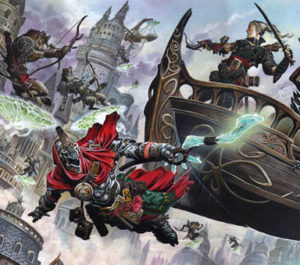
![]() Three sessions into DMing our new D&D 5e Eberron campaign, awesome cinematic combat remains one of my greatest goals.
Three sessions into DMing our new D&D 5e Eberron campaign, awesome cinematic combat remains one of my greatest goals.
What’s amazing is how much there is to consider. At the highest level, excellent presentation and narration of the action is critical.
So how do you get there? More on this in future updates, but for now, here are some things to ask yourself and think about for any heavily cinematic-style D&D campaign you might run:
- Presentation. My playgroup has a mix of preferences and experience for how to represent combat. 2e and some of 3e were heavily graph paper-style in presentation. 3.5 and especially 4e shifted more towards miniatures and grid poster maps or tiles. 5e assumes no combat grid – it’s an optional rule, so the shift to engaging story and away from long, drawn-out, excessively tactical combat is thankfully on. I love exciting, high-stakes combat, and I love brilliant tactics – but not at the expense of the whole point of an adventure being forgotten or a session completely devoured by a couple of sometimes tedious, hours-long combats. With a long, varied D&D history of how to present the action, including 5e’s simpler, more organic approach, it’s still good to think about the pros and cons of all the options. What presentation method – or combination of methods – is the most fluid or least intrusive to 5e’s storytelling strengths? What approach saves the DM the most time before and during sessions? What approach is clearest to players as far as positioning?
- Narration. I’ll never forget reading advice from Stephen King on writing when it comes to character description. He basically said don’t bother. Let the reader fill in those details, as they’re just not important enough. That surprised me, and I now understand why I see less or zero of that in many written stories – or even in monster descriptions, such as the bare bones (or rather, zero bones) ones in 4e. One of my favorite parts of earlier D&D edition monsters were those italicized monster description entries. The five sense were often represented, complete with colors and sounds and much more. I think this is important to the actual play experience of D&D – that’s where live D&D games are different from reading a story. Tabletop gaming like D&D is at its best when we treat it more like a movie than a book. How do the characters and monsters actually look, smell, feel, sound move, speak and fight? I like a dash of theatre in my D&D, so strong in-character or vile, vicious monster roleplaying is essential – especially if you want to achieve truly cinematic combat!
To re-spark ideas and fine tune my DMing skill with cinematic combat, I’ve looked up some great articles from an old friend to Leonine Roar. Glimm the Gnome wrote a host of helpful cinematic combat articles for last edition, and they’re still helpful and inspiring reads now for any TRPG. Want some tips? Join me and check out the Gnome’s action-packed thoughts here.
Next time, I’ll share my 5e presentation style decision and the results so far, including my players’ reactions and feedback.